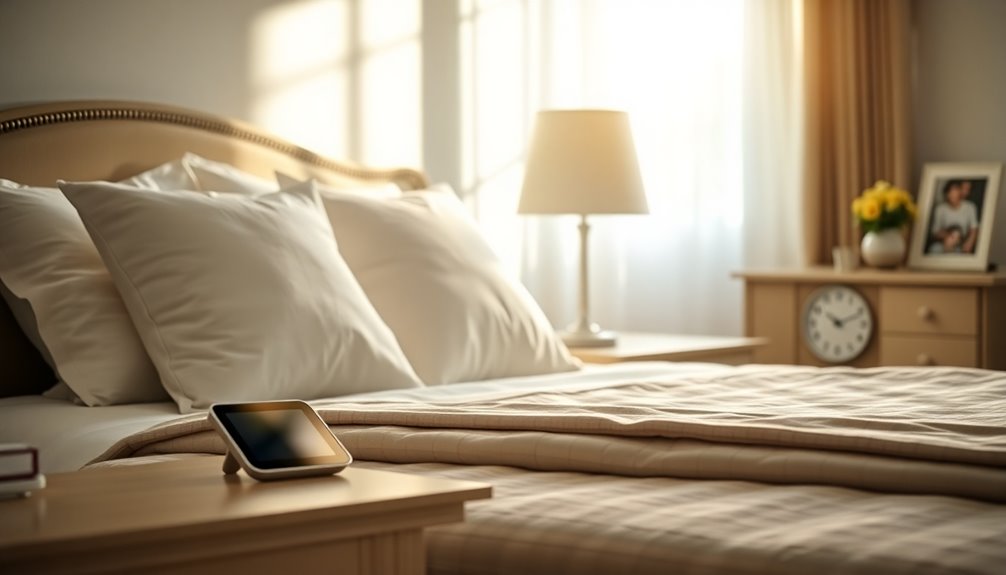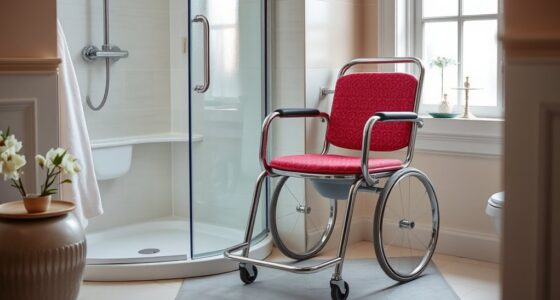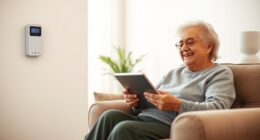I've gathered a list of the 15 best bed alarms for the elderly that can considerably enhance safety and independence. These alarms, like the Lunderg Early Alert Bed Alarm and the Smart Caregiver Wireless Bed Pad Alarm, are designed to detect movement and alert caregivers when an individual gets up. Many models feature adjustable volume settings and are easy to install and maintain. They provide peace of mind, especially for those with mobility issues or dementia. If you're curious about specific features and which one might be the best fit, you might want to explore the options further.
Key Takeaways
- Look for bed alarms with wireless systems that provide a range of up to 500 feet for flexible monitoring without being tethered to the bed.
- Choose models with adjustable volume settings, allowing alerts to be tailored for different environments and ensuring they are heard when needed.
- Select alarms featuring dual modes to distinguish between normal movement and potential falls, reducing false alarms while ensuring safety.
- Consider the ease of installation, with systems that require minimal setup, such as placing a sensor pad under the mattress or sheet.
- Opt for models with durable, comfortable materials that enhance user acceptance and ensure long-lasting use in various bedding types.
Lunderg Early Alert Bed Alarm for Elderly Adults
If you're looking for a reliable solution to monitor elderly loved ones, the Lunderg Early Alert Bed Alarm stands out as an exceptional choice. This wireless bed sensor pad features innovative Pre-Alert Smart Technology that notifies caregivers before patients fully leave their beds, which can prevent potential falls. I appreciate the 10 x 33 inches pressure pad; it's easy to clean and incontinence resistant, making it practical for daily use. The portable pager's adjustable volume lets me customize alerts depending on the time of day. I've found that this alarm considerably eases my worries, particularly for loved ones with dementia. Overall, the Lunderg alarm is a smart investment for ensuring safety and providing peace of mind for caregivers.
Best For: The Lunderg Early Alert Bed Alarm is best for caregivers of elderly and dementia patients who want to prevent falls and ensure safety during the night.
Pros:
- Pre-Alert Smart Technology allows caregivers to be notified before patients fully exit the bed, reducing the risk of falls.
- The incontinence resistant and easy-to-clean pressure pad ensures practicality for daily use.
- The portable pager with adjustable volume settings allows caregivers to customize alerts based on their environment.
Cons:
- The non-replaceable battery in the pad may require future purchases every 15 months.
- Some users have noted the need for a louder alarm option for those with hearing impairments.
- There may be instances where the pad unsyncs from the receiver, requiring a simple resyncing process.
Lunderg Large Bed Alarm for Elderly Adults
The Lunderg Large Bed Alarm stands out as an ideal choice for elderly adults, particularly those dealing with dementia. This wireless bed sensor pad, measuring 20" x 30", connects seamlessly to a handheld monitor that works up to 300 feet away. I love how it triggers an alarm when the patient stands up, providing peace of mind for caregivers. The anti-slip stickers help minimize false alarms, and the pager's adjustable volume settings guarantee alerts are loud enough to be heard. Setting it up is a breeze, as it comes with everything you need. While some users have raised concerns about the build quality and noise, overall, the effectiveness of this alarm in preventing falls is highly praised.
Best For: The Lunderg Large Bed Alarm is best for elderly adults, especially those with dementia, providing caregivers with an effective monitoring solution. The Lunderg Large Bed Alarm is best for elderly adults, especially those with dementia, providing caregivers with an effective monitoring solution. This device not only alerts caregivers when a loved one attempts to get out of bed but also enhances safety by reducing the risk of falls. For those seeking additional safety measures, pairing the alarm with the best bed rails for seniors can create a comprehensive safety system that ensures peace of mind for both seniors and their caregivers.
Pros:
- Peace of Mind: Alerts caregivers immediately when the patient stands up, reducing the risk of falls.
- User-Friendly Setup: Comes with all necessary components and clear instructions for easy installation.
- Adjustable Volume Options: The portable pager allows caregivers to choose between high, low, or vibration alerts based on their needs.
Cons:
- Build Quality Concerns: Some users report issues with the durability of the pad and pager, including connection problems.
- Delayed Response Trigger: The alarm may only activate once the individual is fully out of bed, which could delay caregiver response.
- Noisy Pad Material: The sound of the pad could be disruptive for sensitive patients, potentially affecting their comfort.
Patient Bed Alarm with Motion Sensor
Designed specifically for fall prevention among the elderly, the Patient Bed Alarm with Motion Sensor stands out with its 10 x 30 bed pad that triggers an alarm when movement is detected. I love that it offers two ring chime options and can be mounted in various ways, making it incredibly versatile. The alarm's volume is adjustable, reaching up to a loud 90db, which guarantees it's heard even in another room. Plus, its advanced vinyl material is tear-and water-resistant, which makes cleaning a breeze. I appreciate the one-button reset feature, making it easy to silence after it triggers. With a one-year warranty and excellent customer service, I feel confident this alarm enhances safety and independence for my loved ones.
Best For: The Patient Bed Alarm with Motion Sensor is best for elderly individuals at risk of falls and caregivers looking for effective fall prevention solutions.
Pros:
- Easy installation with multiple mounting options, including U-bracket, wall mounting, and adhesive velcro strips.
- Loud alarm with adjustable volume settings, ensuring it can be heard from other rooms.
- High-quality, durable materials that are tear-and water-resistant, making maintenance simple.
Cons:
- The alarm may be triggered by minor movements, which could be annoying for some patients.
- Limited effectiveness for applications requiring sound in multiple rooms unless a wireless pad is used.
- Some users may find the alarm volume too loud for comfort, especially in close quarters.
Upgraded Bed Sensor Alarm for Elderly and Caregiver Pager
For families caring for elderly loved ones, the Upgraded Bed Sensor Alarm proves invaluable, especially for those with dementia or Alzheimer's. I found this system to be incredibly effective, with wireless motion sensors that easily detect movement under the bed or at the door. The alarm triggers instantly, alerting me from up to 918 feet away. I love the dual reminders—bright LED lights and sound—making sure I don't miss any alerts, even if I'm in another room. Setup was a breeze, and the customizable alarm tones are a nice touch. However, I wish it had a power indicator light. Overall, this alarm enhances safety and gives me peace of mind, knowing I can respond quickly if my loved one needs assistance.
Best For: Families caring for elderly individuals, particularly those with dementia or Alzheimer's, who need an effective monitoring solution to enhance safety and respond quickly to their loved ones' needs.
Pros:
- Wireless motion sensors allow for flexible placement and easy movement detection.
- Dual reminders with bright LED lights and sound ensure alerts are noticeable from a distance.
- Customizable alarm tones and straightforward setup enhance user experience.
Cons:
- Lack of a power indicator light can lead to uncertainty about the unit's status.
- The wide detection beam may cause false alarms if patients linger near the bed.
- High volume on the lowest setting may be excessive for some users.
Smart Caregiver Wireless Bed Pad Alarm System
If you're looking for a reliable solution to help monitor an elderly loved one, the Smart Caregiver Wireless Bed Pad Alarm System stands out. This system features a 10 x 30 weight-sensing bed pad made from soft, latex-free vinyl, ensuring comfort for your loved one. Its wireless operation covers up to 300 feet, letting you attend to other tasks while keeping an eye on them. The pager provides sound and vibrate alerts, so you'll never miss a notification when they attempt to get out of bed. Setup is simple—just place the pad under their shoulders or hips. Many users rave about the peace of mind it brings, making it a valuable investment for enhancing safety and independence.
Best For: Caregivers and families looking for a reliable solution to monitor elderly loved ones and prevent falls.
Pros:
- Wireless operation allows caregivers to monitor patients from a distance of up to 300 feet, enhancing flexibility.
- Easy setup with a simple placement of the bed pad under the patient's sheets, making it user-friendly for all caregivers.
- Effective alerts through sound and vibrate notifications ensure caregivers are promptly informed when patients attempt to leave the bed.
Cons:
- Battery-operated pager may require regular battery replacements, which can be inconvenient.
- Sensitivity adjustments may be needed for optimal placement, which could take some trial and error.
- Limited to bed use, which may not cover all areas where falls could occur, requiring additional monitoring solutions.
Lunderg Under Mattress Bed Alarm for Elderly Adults & Chair Alarm Set
With its wireless early-alert system, the Lunderg Under Mattress Bed Alarm is an excellent choice for caregivers looking to enhance the safety of elderly loved ones. I love how this alarm includes both a bed pad and a chair pad, allowing me to monitor my family member's movements effectively. The PVC material feels comfortable, and I appreciate that it doesn't crinkle. The wireless connectivity reaches up to 300 feet, which gives me flexibility in monitoring. I've found the adjustable volume settings on the portable pager handy for both day and night use. Users have shared positive experiences, noting fewer falls and timely alerts. Overall, it's a reliable option that provides peace of mind for caregivers like me.
Best For: Caregivers seeking a reliable and effective monitoring system for elderly loved ones to prevent falls.
Pros:
- Includes both bed and chair pads for comprehensive monitoring of movements.
- Wireless connectivity allows for flexible monitoring up to 300 feet away.
- Adjustable volume settings on the pager cater to different environments and preferences.
Cons:
- The bright LED light may be distracting at night and lacks a dimming option.
- The on/off switch's accessibility can be inconvenient; a remote switch is recommended.
- The pad's battery has a limited lifespan and cannot be replaced, raising long-term usability concerns.
Lunderg Bed Alarm for Elderly Adults – Wireless Bed Sensor Pad
Finding the right bed alarm for elderly adults, especially those with dementia, can be challenging. That's why I appreciate the Lunderg Bed Alarm. This wireless bed sensor pad, measuring 10" x 30", connects seamlessly up to 300 feet away, allowing me to monitor my loved one from another room. When they stand up, the alarm alerts me with either sound or vibration, which is reassuring. The anti-slip design minimizes false alarms, and it's easy to set up with everything included, even batteries. Users rave about its effectiveness, especially when compared to other systems that trigger frequent false alarms. While some comfort issues were noted, the overall peace of mind it provides makes it a valuable addition to any home.
Best For: Elderly adults, particularly those with dementia, and their caregivers seeking a reliable monitoring solution for nighttime safety.
Pros:
- Wireless connection allows monitoring from up to 300 feet away, providing flexibility for caregivers.
- Anti-slip design minimizes false alarms, enhancing overall reliability.
- Easy setup with all necessary components included, making it user-friendly.
Cons:
- Some users have reported discomfort with the sensor pad, leading to its removal.
- Suggestions for improving the pad's stability around the mattress have been noted.
- Limited options for additional securing features to enhance performance.
Smart Caregiver Wireless Motion Sensor Alarm System
The Smart Caregiver Wireless Motion Sensor Alarm System stands out as an excellent choice for caregivers looking to enhance the safety of elderly individuals at risk of falling. This system includes a motion detector that alerts me from up to 300 feet away, making it perfect for monitoring bed or door movement. I love that it sends a silent wireless signal to my pager, so it won't startle the resident. The pager's sound level is 75 dB, which is effective, though I wish there was a volume control. With minimal battery changes and a 90-day warranty, it's reliable and user-friendly. Plus, the positive customer service experiences give me confidence in my purchase.
Best For: Caregivers of elderly individuals at risk of falling or wandering, especially those with dementia.
Pros:
- Silent alerts: Sends a wireless signal to the pager without alarming the resident, reducing stress.
- Extended range: Detects motion from up to 300 feet away, allowing caregivers to monitor from a distance.
- User-friendly: Minimal battery changes required and positive customer service experiences reported.
Cons:
- No volume control: The pager's sound level is fixed at 75 dB, which may be too loud for some users.
- Batteries not included: Requires separate purchase of batteries for both the motion sensor and pager.
- Limited warranty: The 90-day warranty period may be shorter than some users expect for a safety device.
Patient Aid Advanced Bed and Floor Alarm for Elderly Monitoring
For anyone seeking a reliable solution to monitor elderly loved ones, the Patient Aid Advanced Bed and Floor Alarm stands out due to its impressive loud alarm, which guarantees caregivers are alerted whenever a patient attempts to get out of bed. The 10 x 30 inches underpad fits comfortably under the patient, and it's made from durable, water-resistant vinyl. With adjustable volume settings reaching up to 95db, you can make certain the alarm is audible throughout your home. Installation is quick; you can choose from various mounting options, making it easy to set up. While some users noted sensitivity issues and a lack of securing straps, the overall effectiveness in alerting caregivers makes it a crucial tool for safety and independence.
Best For: Caregivers of elderly individuals who require monitoring to ensure their safety and independence.
Pros:
- Loud alarm that is audible throughout the house, ensuring caregivers are alerted promptly.
- Durable and comfortable design made from tear and water-resistant vinyl, suitable for vigorous use.
- Quick installation with multiple mounting options, allowing for easy setup in various environments.
Cons:
- Some users reported sensitivity issues, with the alarm activating from slight movements.
- Lack of securing straps can lead to the pad bunching, affecting usability.
- Instructions may be unclear, leading to reliance on trial and error for setup.
Caregiver Alarm & Fall Prevention System with Chair Pad
With its motion sensor technology, the Caregiver Alarm & Fall Prevention System with Chair Pad is an ideal choice for anyone caring for elderly individuals at risk of falls. I love how easy it is to install—just mount the alarm out of reach and place the chair pad beneath the patient. The pad is tear-resistant, water-resistant, and easy to clean, making it perfect for daily use. When a patient attempts to stand, the motion sensor alerts you with a loud chime or music, giving you peace of mind while you tend to other tasks. I appreciate the 1-year warranty and the clear instructions provided, ensuring this system remains a reliable safety measure in your caregiving routine.
Best For: Caregivers of elderly individuals at risk of falls, seeking a reliable and easy-to-use safety solution.
Pros:
- Easy Installation: Quick setup with multiple mounting options allows for flexibility in placement.
- Effective Alerts: Loud motion sensor alarms provide timely warnings when patients attempt to stand, enhancing safety.
- Durable Design: The chair pad is tear-and-water resistant, making it suitable for everyday use and easy to clean.
Cons:
- Volume Limitations: While some users find the alarm loud enough, others report it may not be heard in adjacent rooms with noise.
- Limited Lifespan: The one-year warranty indicates a finite usage period, which may require future investment.
- Additional Safety Needs: Users may need to implement extra safety measures, such as door knob protectors, for enhanced security.
CallToU Bed Alarm for Elderly Adults
Designed specifically for elderly adults, especially those living with dementia, the CallToU Bed Alarm offers peace of mind to caregivers. This wireless motion sensor alarm alerts me when my loved one gets out of bed, helping prevent falls and ensuring prompt assistance. With a detection range of up to 33 feet and a wireless signal reaching 500 feet, I can monitor movements from anywhere in the house. The system's reliability is impressive, and I appreciate the adjustable volume options on the portable pager, ensuring I never miss an alert. Plus, it supports multiple sensors, allowing for thorough monitoring. Knowing that I can customize alert sounds adds a personal touch, making caregiving a little easier.
Best For: Elderly adults, particularly those with dementia, and their caregivers seeking to enhance safety and reduce the risk of falls.
Pros:
- Highly sensitive motion detection ensures prompt alerts when a loved one gets out of bed.
- Expandable system allows for multiple sensors and receivers, providing comprehensive home coverage.
- Customizable alert sounds and adjustable volume levels enhance the user experience and personalization.
Cons:
- Wireless range may vary depending on environmental interferences, potentially affecting performance in larger homes.
- Initial setup might require some technical knowledge, which could be challenging for some users.
- Battery dependency for sensors and pager means regular maintenance to ensure functionality.
Early Alert Bed Alarm for Elderly Adults, Wireless Bed Sensor Pad & Pager
The Early Alert Bed Alarm stands out as an ideal solution for elderly adults, particularly those at risk of falls due to mobility issues or dementia. With its wireless bed sensor pad measuring 18 x 36 inches, it instantly alerts me when my loved one tries to get out of bed. The pager has two alarm modes, so I can easily distinguish between a simple movement and a potential fall. Its impressive wireless range of up to 400 feet means I can monitor from a distance, reducing the need for constant checks. Made from high-quality, stretchy PU material, the pad is comfortable for users. Plus, it comes with a one-year warranty, ensuring durability and peace of mind for caregivers like me.
Best For: Elderly adults, particularly those with mobility issues or dementia, who require fall prevention monitoring at home.
Pros:
- Reliable wireless range of up to 400 feet allows for convenient monitoring from a distance.
- Two alarm modes help caregivers distinguish between normal movement and potential falls, enhancing safety.
- Made from high-quality, stretchy PU material, ensuring comfort for users while being durable.
Cons:
- The size of the pad (18 x 36 inches) may not fit all bed types or setups.
- Wireless functionality might experience interference in certain environments, affecting performance.
- Requires batteries for the pager, which may necessitate regular replacement.
WiFi Smart Bed Sensor Alarm for Elderly and Seniors
If you're caring for an elderly loved one or someone with dementia, the WiFi Smart Bed Sensor Alarm is an invaluable tool. This device features a caregiver motion sensor that alerts you via an app when your loved one moves, no matter where you are. You can place the sensor under the bed or on a doorframe, ensuring accurate monitoring. With a range of 330 feet outdoors and 30-150 feet indoors, you'll stay connected as long as the hub is within Wi-Fi range. I love that the Smart Life app lets multiple users receive alerts, making it easy to share monitoring responsibilities. Plus, setup is straightforward, and many users have praised its effectiveness in enhancing elderly care.
Best For: Individuals caring for elderly loved ones or seniors with dementia who need reliable movement monitoring.
Pros:
- Easy setup through the Smart Life app, making it user-friendly for caregivers.
- Wide range of motion detection, with up to 330 feet outdoors, ensuring connectivity in various settings.
- Multiple user sharing feature allows several caregivers to receive alerts, enhancing collaborative care.
Cons:
- Limited to 2.4GHz Wi-Fi, which may require network adjustments for some users.
- Indoor range can vary significantly (30-150 ft), potentially affecting reliability in larger spaces.
- Dependence on the hub's Wi-Fi connection, meaning alerts may not be received if the internet is down.
Smart Caregiver Bed and Chair Exit Alarm System
For caregivers seeking a reliable way to confirm the safety of elderly individuals, especially those with dementia, the Smart Caregiver Bed and Chair Exit Alarm System stands out. This system includes soft, incontinence-resistant sensor pads for both beds and chairs, alerting you when your loved one gets up. Users rave about the peace of mind it provides, as it helps prevent falls during the night. While some have faced challenges—like family members learning to silence the alarm—making adjustments can enhance functionality. You might consider hiding the reset switch or positioning the alarm on the floor for better activation. Overall, I recommend testing it in different settings to confirm it meets your specific needs before fully relying on it.
Best For: Caregivers of elderly individuals, particularly those with dementia or Alzheimer's, who need reliable fall prevention solutions.
Pros:
- Effective alerts: Successfully notifies caregivers when a loved one gets up, helping prevent falls.
- Peace of mind: Provides reassurance for caregivers, allowing them to rest easier at night.
- Customizable: Users can make adjustments to enhance performance according to individual needs.
Cons:
- Learning curve: Some elderly individuals may figure out how to silence the alarm, requiring additional modifications.
- Volume inconsistency: The alarm's sound level may be too loud or too soft for different environments, affecting its effectiveness.
- Installation challenges: Users have reported difficulties with battery installation and inconsistent performance.
Smart Caregiver Bed Exit Alert for Elderly Fall Prevention
Designed specifically for elderly individuals at risk of falls, the Smart Caregiver Bed Exit Alert stands out due to its weight-sensing pad that alerts caregivers when a patient exits the bed. This 10×30 inch pad is made from soft, latex-free vinyl and is sealed for incontinence protection, making it both comfortable and practical. I love how easy it is to install—just slide it under the fitted sheet for ideal detection. With adjustable volume and a low battery indicator, I can easily keep track of its status. Many users, including myself, appreciate the peace of mind it brings, especially at night. However, I recommend getting an AC adapter to avoid frequent battery replacements.
Best For: Elderly individuals, patients with dementia, or those recovering from strokes who are at risk of falls.
Pros:
- Alerts caregivers effectively when a patient exits the bed, enhancing fall prevention.
- Easy installation by sliding the pad under a fitted sheet, ensuring optimal detection.
- User-friendly design with adjustable volume and low battery indicator for convenience.
Cons:
- Some users report sporadic functionality after a few months, necessitating frequent battery changes.
- The lack of an AC adapter may lead to ongoing battery replacement issues.
- Accessing the battery compartment requires a mini-screwdriver, which can be inconvenient.
Factors to Consider When Choosing a Bed Alarm for Elderly

When I'm choosing a bed alarm for my elderly loved one, I always consider a few key factors. Alarm sensitivity and wireless range can really impact its effectiveness, while ease of installation and battery life are also essential for everyday use. Plus, I want to make sure the design prioritizes comfort for the user.
Alarm Sensitivity Settings
Choosing the right alarm sensitivity settings is vital for guaranteeing both safety and comfort for elderly patients. I've learned that these settings determine how easily the device detects movement. A higher sensitivity can provide accurate alerts but may also lead to annoying false alarms from minor movements, like shifting in bed.
I appreciate that some bed alarms allow caregivers to adjust the sensitivity level, allowing me to customize it based on the patient's specific needs and mobility. However, I've found that if the setting is too high, caregivers might experience fatigue from constant notifications. On the other hand, a sensitivity setting that's too low could fail to alert us when the patient genuinely attempts to get out of bed, raising the risk of falls.
It's imperative to test and calibrate the sensitivity settings in real-world conditions. Taking the time to find that sweet spot guarantees peak performance and reliable alerts for fall prevention. Ultimately, balancing sensitivity will enhance safety for our loved ones while also keeping us from feeling overwhelmed by unnecessary alarms.
Wireless Range Limitations
After confirming the alarm's sensitivity is just right, the next factor I consider is the wireless range limitations of the bed alarm. Most wireless alarms operate within a range of 300 to 500 feet in open spaces, but this can drop considerably indoors. Walls, furniture, and even the materials used in construction can hinder the signal, so I always think about my home's layout.
I also take into account that some devices might face interference from other electronics using similar frequencies, which can affect their reliability. If the caregiver is too far away, delayed alerts could occur, possibly compromising timely assistance when help is needed most.
When I'm choosing a bed alarm, I make sure to evaluate whether the specified wireless range fits my needs, especially in larger homes. It's crucial to verify that I can receive alerts wherever I am, without worrying about being out of range. A dependable wireless connection can make all the difference in providing safety and support for my loved ones, allowing them to maintain their independence while knowing help is just a signal away.
Ease of Installation
Since I want to guarantee a bed alarm is effective and user-friendly, I always prioritize ease of installation. Many bed alarms have a simple setup process, often just requiring the placement of a sensor pad under the mattress or fitted sheet. This means I can get everything ready without needing specialized tools or a complicated assembly.
I also appreciate that wireless bed alarms typically have a range of up to 300 feet. This flexibility allows caregivers to position the pager in convenient spots while ensuring alerts are received quickly. Extensive packages usually include all necessary components, such as batteries and mounting accessories, making the whole process hassle-free.
Some systems even provide instructional videos or clear written guides, which I find incredibly helpful during the activation and pairing process. These resources cut down on confusion and make it easier for me or my loved ones to get everything set up correctly. Plus, many bed alarms are compatible with various mattress types, so integration into existing bedding setups is usually smooth and straightforward. When ease of installation is prioritized, it enhances overall safety and reliability in the home.
Battery Life Considerations
When selecting a bed alarm for the elderly, battery life is vital. I've noticed that the battery longevity can vary quite a bit, with some pads lasting around 12 to 15 months, while others may need replacements sooner, depending on how sensitive the settings are. It's important to take into account whether the alarm uses replaceable batteries or not; some models have non-replaceable batteries, which means I'd need to replace the entire pad once the battery dies.
The type of battery also plays a significant role in how long the device lasts. Some alarms use standard alkaline batteries, while others might offer rechargeable options or even AC adapter power supplies. I've learned that regular testing and monitoring of battery levels is essential. Sometimes, those low battery alerts aren't as reliable as I'd hope.
Lastly, I'd recommend checking how easy it is to replace the battery or access it. Some designs complicate this process, which can be a hassle and affect overall user experience. Taking these factors into consideration will help guarantee consistent functionality and peace of mind.
User Comfort Design
User comfort is a top priority for bed alarms aimed at the elderly. I know how important it is for these devices to feature soft, latex-free materials that prevent discomfort while lying down. When I'm choosing a bed alarm, I pay close attention to the size and shape of the sensor pad. It should fit various mattress types and thicknesses to guarantee effective detection without compromising comfort.
I also appreciate features like stretchable, odorless, and easy-to-clean materials. These enhance the overall experience and make it more user-friendly. Noise can be a huge issue, too. A design that minimizes noise from the pad material can help avoid startling sensitive individuals during the night, promoting a more restful sleep environment.
Additionally, I look for anti-slip designs that secure the pad in place. This reduces movement that could lead to discomfort or false alarms, which is essential for maintaining peace of mind. Overall, I believe that prioritizing user comfort in bed alarms not only enhances safety but also promotes independence for the elderly, ultimately improving their quality of life.
Frequently Asked Questions
How Do Bed Alarms Improve Safety for Elderly Individuals?
I believe bed alarms considerably improve safety for elderly individuals. When someone gets out of bed, the alarm alerts caregivers or family members, ensuring help is on the way if needed. This quick response can prevent falls and injuries, which are common in the elderly. Plus, knowing there's a system in place can give both seniors and their loved ones peace of mind, allowing everyone to feel more secure and independent.
Are Bed Alarms Suitable for All Types of Beds?
I've found that bed alarms can be suitable for many types of beds, but it really depends on the specific model. Some alarms work well with traditional mattresses, while others are designed for adjustable or hospital beds. It's important to check the compatibility of the alarm with your bed type before purchasing. I always recommend reading reviews or consulting with the manufacturer to guarantee it'll function properly in your situation.
Can Bed Alarms Be Used With Pets in the Bed?
I remember the night my dog jumped up, and I nearly fell off the bed! It got me thinking about bed alarms. Yes, bed alarms can work with pets in the bed, but it depends on the design. Some alarms are sensitive enough to detect movement, while others might get triggered by a playful pet. So, if you're considering one, check how it responds to your furry friends before making a decision.
How Often Should Bed Alarms Be Tested for Functionality?
I think it's essential to test bed alarms regularly to guarantee they're functioning properly. I usually check mine at least once a month. This way, I can catch any issues before they become a problem. If I notice any irregularities, I'll test them more frequently until I'm confident they're in good working order. Keeping them reliable gives me peace of mind, knowing I'm prepared for any situation that might arise.
What Is the Average Lifespan of a Bed Alarm Device?
The average lifespan of a bed alarm device typically ranges from three to five years, depending on the brand and usage. I've found that regular maintenance can extend its functionality. It's crucial to check the manufacturer's guidelines for specific details. I always recommend keeping an eye on battery life and any signs of wear. Staying proactive can guarantee the device remains reliable and effective for your needs over time.
Conclusion
In the grand tapestry of life, a bed alarm symbolizes the thread of safety woven into our daily routines. Choosing the right one for the elderly isn't just about technology; it's about empowering independence and nurturing peace of mind. These devices stand as vigilant guardians, ready to alert caregivers when needed, ensuring our loved ones can rest easy. By investing in the right bed alarm, we're not just enhancing safety; we're enriching lives and preserving dignity.
























